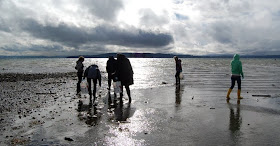
The water in our Salt Water Tide Pool tends to change a bit in clarity over the course of a week. On days where we have a lot of visitors, the water gets cloudier. When attendance is low, the water tends to clear up a bit. But recently, regardless of attendance, the water has just been cloudy – even murky. Our ammonia, pH and other tests were within healthy range and the animals were thriving. But guests had difficulty seeing the animals. The purpose of our exhibit is to educate and create a sense of wonder and stewardship, and our touch tank was not meeting this need. We needed to fix it, on a shoestring budget, but how?
There are four types of filtration – biological, chemical, physical and mechanical. Our tide pool uses all of them. To create a more robust and successful filtration system, we knew we would need to make sure we were fully utilizing each of these types of filtration.

Biological filters use bacteria to break down wastes excreted by animals into less toxic products. In our tide pool, we use “bio balls” which provide extensive surface area and for the growth of good bacteria. Our water quality measurements were good, so we had adequate biological filtration.
Chemical filtration uses carbon to removes toxins and impurities from water by binding them to material that can then be removed and disposed of. If it’s overused, it also captures trace minerals needed for a healthy system. Using chemical filtration alone is not an option.

Our protein skimmer uses physical filtration. When protein is mixed in water, it forms bubbles. It’s like a meringue made of sea scum instead of egg whites. B y capturing and discarding the foam, you remove the unwanted protein from the water. But protein does not causing cloudiness, so adding more physical filtration would not solve our problem.
Mechanical filtration captures loose particles in water, using some kind of straining material. We had been using filter canisters made of a fine metal mesh, as well as felt-like filter fabric. However, water was leaving these filters as cloudy as it went in. The mechanical filtration appeared to be the weak link.

Our first step was to identify the most efficient medium for mechanical filtration for our size of tank We knew that crushed coral would function as both a mechanical and biological filter, and this seemed like the ideal option. This main issue with coral was its weight. It is pretty heavy when it comes in bulk, and with our current vats, it would be difficult to keep the coral from getting into the filters, and nearly impossible to remove it when we needed to. So how to you suspend 100 pounds of crushed coral inside a 500-gallon vat and still maintain relative accessibility? The answer came to Animal Caretaker Dan Warner while he was washing dishes: A sink!

We retrofitted a slop sink with added drainage holes. Then we sealed netting to the bottom to keep the coral in place. Water flows from the tide pool and into this sink full of coral which now provides our main source of filtration. Then it drains from the sink into the vat, where it’s pumped back out into the tide pool again.

But the fun doesn’t stop there. To provide even greater mechanical filtration, we started using hula hoops buoyed by water noodles! They now support felt filter media that lies above the sink to and captures the largest bits of junk, such as uneaten food, hair, and spines shed by sea urchins.
And as Dan says, “Bob’s your uncle!” We have the filter of our dreams for a fraction of what it would cost to buy a new one.

Does it work? The BEFORE picture is typical of our system mid-week, when attendance is brisk but not heavy. The AFTER picture was taken after the very busy “Polar Science Weekend”, and shows that even on one of our busiest days, the coral is up to the task.

Thanks to Lead Animal Caretaker Brianna Todd for the photographs to this story.































